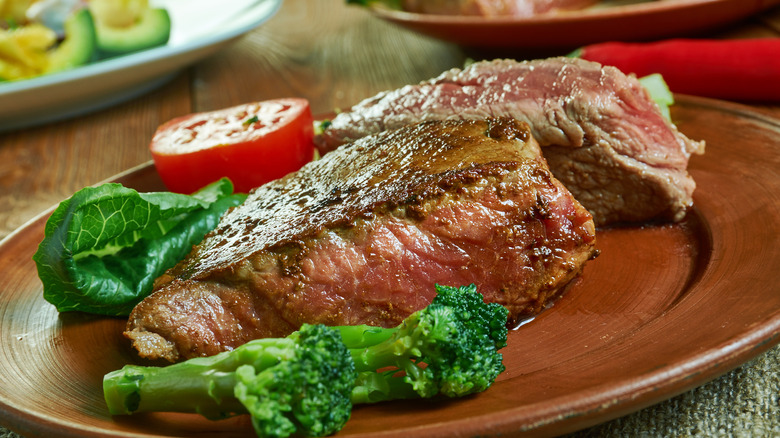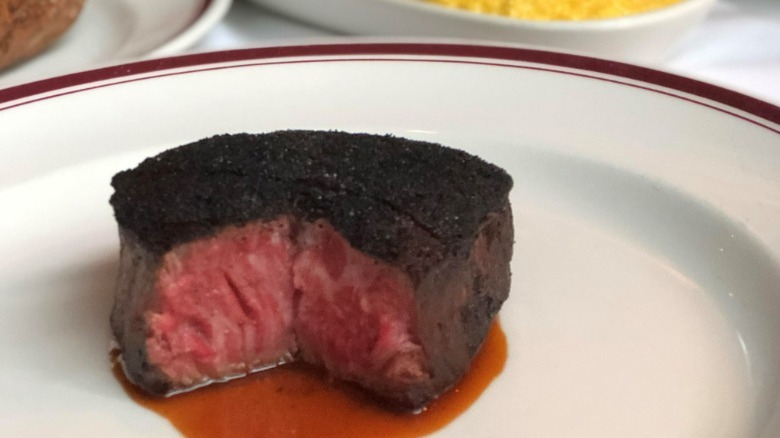What Is A 'Pittsburgh-Style' Steak And How Is It Cooked?
You've probably heard of Philly-style steaks, or more accurately, the Philly cheesesteak. While who invented this iconic sandwich is still something Philadelphians debate, the thinly-sliced steak, cheez-wiz, and onion filling remain the classic symbol of Pennsylvania-style cuisine. Of course, other regions of the Keystone State have their own unique dishes, just as Philadelphia has cheesesteaks.
Pizza Magazine Quarterly tells us that Old Forge, Pennsylvania, is "the pizza capital of the world," right up there alongside New York and Chicago. Old Forge-style pizza is described as having a bread-like crust cooked in a deep pan and served with a robust onion-laced sauce that's more like spaghetti sauce than your average pizza sauce. The Coal Regions of Pennsylvania enjoy "boilo," a hot drink made of whiskey, fruit, and spices, around the holiday season, with the drink's roots going as far back as the first Lithuanian immigrants (via PennLive). And of course, no culinary trip to Pennsylvania is complete without talking about Hershey Park and the iconic chocolate factory.
But while you may have heard about cheesesteaks and Hershey bars, you've probably never heard about Pittsburgh-style steaks. While this dish isn't a cheesesteak, it does involve a specific way of cooking your steak.
Pittsburgh-style steaks are both well-done and rare
When you're asked to describe what rare means in terms of steak, you probably describe it as the inside being red. If you're asked to describe what a well-done steak looks like, you might say it has a noticeable black char, or crust, on the exterior. These two descriptions may be completely opposite, but if you were to have Pittsburgh-style steak, you might be surprised to find it both rare and well-done all at once.
According to PhillyBite, your typical Pittsburgh-style steak usually is charred on the outside while maintaining a bright pink center. While these steaks may differ on how charred or how pink they are depending on where you visit, the main cooking method behind this type of steak involves placing it over an open flame at a very high temperature. Although the steak is finished off on the grill, the open flame method ensures that you get that characteristic dark crust on the exterior.
Chef Billy Parsi explains that Pittsburgh-style steak is also called a "black and blue," and describes it as something of an oddity in the world of steak. While the exterior has a "leathery taste," at least to Parsi, the interior is actually very delicate and flavorful, a tender and moist interior to compare against the rough, burnt crust. Although it may not be for everyone, Parsi does note that there are many fans of this unique steak style.
How did Pittsburgh-style steak come to be?
While the idea of charring steaks isn't exactly a new idea in the world of grilling, one can only wonder how the concept of charring a steak until it's black came about in Pittsburgh and more importantly, why it stuck in the city's culture.
According to Serious Eats, Pittsburgh-style steaks may have origins in the city's famous steel mills. Workers would supposedly cook their meat on the scalding-hot blast furnaces, and the extreme temperature of the furnaces would nearly instantly char the meat until it was black, then the worker would quickly remove the cooked steak to keep it from burning into charcoal. This cooking method allowed the workers to eat an entire piece of steak during a short lunch period without having to wait for it to cook on a grill or stove.
Pittsburgh Beautiful shares another story from 1958 that involves a local diner known as The Colony Restaurant. A patron's steak was accidentally burnt and the cook, perhaps making a joke of the situation or trying to calm an angry customer, claimed the charred steak was known as "Pittsburgh-style." Clever!
You'll find a few more possible origin stories of the Pittsburgh-style steak, but however it came to be, it has managed to earn its spot in the hearts of Pittsburgh diners for many generations.


